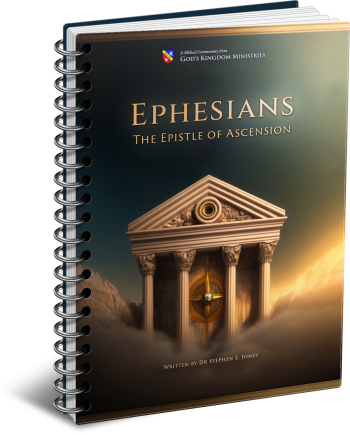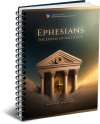Latest Posts
View the latest posts in an easy-to-read list format, with filtering options.

Paul's epistle to the Ephesians is, in some ways, a continuation of his epistle to the Romans. It enlarges upon Romans 1-8 in regard to the believer's position and right standing with God. We are "seated" with Christ, so we must "walk" according to our calling, and "stand" in the full armor of God against those who would oppose us.
Category - Bible Commentaries

Eph. 6:17 reads,
17 And take the helmet of salvation and the sword of the Spirit, which is the word of God.
These are the last two items of the armor of God that Paul lists in this passage. There are six pieces of armor, although for some reason Dr. Bullinger’s notes in The Companion Bible add a spear to the list to make it seven. He does not explain why.
No doubt Paul learned about “a helmet of salvation” from Isaiah 59:17, where it is mentioned by the prophet, along with the breastplate of righteousness.
17 He put on righteousness like a breastplate, and a helmet of salvation on His head…
A helmet covers one’s head. Our Head is Jesus Christ. Jesus’ Hebrew name is Yeshua, which means “salvation.” Hence, “the helmet of salvation” is also the helmet of Yeshua-Jesus. No doubt Paul meant to identify the helmet with Jesus, who is our salvation.
Throughout the Old Testament, the word yeshua (and yasha) prophesy of Christ. Yet the connection was obscure until the angel of the Lord appeared to Joseph in a dream. The angel confirmed to him that Mary had indeed been impregnated by the Holy Spirit and that he was to name the boy Jesus (or Yeshua). The reason for this name was that “He will save His people from their sins” (Matt. 1:21).
It seems, then, that Joseph was among the first to receive the revelation connecting the word yeshua to the salvation that was to come through the Messiah by that name. Even Mary did not seem to receive this revelation, though an angel had appeared to her earlier. That conversation focused on the significance of the virgin birth.
It was revealed to her too that “the power of the Most High will overshadow you; and for that reason the holy Child shall be called the Son of God” (Luke 1:35). In other words, Christ was called the Son of God specifically because she had been impregnated, not by Joseph or any man, but by “the Most High.”
It is the same with us, if we have been begotten by God and if we have transferred our identity to the new creation man. Jesus set the pattern for all of the sons of God.
On the eighth day from His birth, Jesus was presented to the priest at the temple, where He was formally registered under the name Yeshua (Luke 2:21). There, an old man named Simeon recognized Jesus as the Messiah. No doubt he had received revelation—perhaps many years earlier—that the Messiah’s name would be Yeshua and that He would be born on the feast of Trumpets (the Hebrew New Year’s Day). He knew, therefore, that He would be presented at the temple on the eighth day of the new year.
Simeon had received a personal promise from God that he would see the Messiah before he died (Luke 2:26). Hence, Simeon was waiting at the temple on the eighth day of that new Hebrew year to see if parents would bring a son to the temple for dedication and see if they would call His name Yeshua.
Luke 2:27-30 says,
27 And he came in the Spirit into the temple; and when the parents brought in the child Jesus to carry out for him the custom of the Law, 28 then he took Him into his arms, and blessed God, and said, 29 Now, Lord, You are releasing Your bond-servant to depart in peace, according to Your word, 30 for my eyes have seen Your salvation [“Yeshua”].
More recently, a well-respected Rabbi, Yitzhak Kaduri, made the same discovery before he died at the age of 108. He claimed that he had met the messiah named Yehoshua or Yeshua. However, he was referring to another man living today. He must have discussed this with other prominent rabbis, because a number of them shared that belief.
http://www.yeshuahamashiach.org/Kaduri_names_Messiah.htm
The point is that the revelation of the Messiah’s name in Scripture is not so obscure that one cannot know it. Unfortunately, having rejected Jesus as the Messiah, they look for another by that name. One cannot put on the helmet of salvation apart from the true Yeshua.
The helmet of Yeshua is for those who believe that Jesus is “the Christ, the Son of the living God” (Matt. 16:16). False messiahs are born of fleshly seed, which cannot result in immortality or incorruption (1 Peter 1:23-25). Neither can any false messiah be called the Son of God, because he was not begotten by the Most High God.
Perhaps Paul was referring to the helmet of Yeshua when he wrote in Rom. 13:14,
14 But put on the Lord Jesus Christ, and make no provision for the flesh in regard to its lusts.
When we compare Roman armor to the attire of the high priest, we see that the helmet of salvation is comparable to the high priest’s turban. Lev. 8:9 says,
9 He also placed the turban on his head, and on the turban [“mitre,” KJV], at the front, he placed the golden plate, the holy crown, just as the Lord had commanded Moses.
This turban was made of fine linen (Exodus 28:39). A blue thread was attached to it (Exodus 28:37) to “remember all the commandments of the Lord” (Num. 15:38-40). Blue is the color of the sky as well as the law. Hence, Paul wrote in Rom. 7:14, “we know that the law is spiritual.”
On the turban was placed the nezir, “the holy crown” (Exodus 29:6), which consecrated the high priest with the calling of a Nazirite. Nazirites were allowed to enter the sanctuary as if they were priests. James, the brother of Jesus, was a Nazirite, and he used to pray daily in the sanctuary for the city of Jerusalem—until he was stoned for his belief in Jesus (62 A.D.). See Lessons from Church History, Vol. 1, chapter 25.
The golden plate was inscribed with the words, “Holy to the Lord” (Exodus 39:30). We know that our great High Priest is Jesus Christ Himself. Even though Jesus was not an Old Covenant priest, nonetheless, both Moses and Aaron were types of Christ in their own ways. Therefore, the garment of the high priest was a fleshly representation of spiritual garments given to our High Priest of the Order of Melchizedek. So the turban, with its golden plate, can be viewed as the helmet of salvation, or the helmet of Yeshua.
Our High Priest was sinless, having fulfilled the law throughout His lifetime (Heb. 9:28, KJV). His “turban” had a blue thread to remember all of the commandments. Though He was often accused of sin by His enemies, those accusations were false. He violated the common understanding of the law—the Sabbath law in particular—but, in fact, healing people on the Sabbath was not a sin. It was designed to help people enter God’s rest, which was why the Sabbath was given.
As for the golden plate, or the holy crown, Heb. 5:1 and 3 says,
1 For every high priest taken from among men is appointed on behalf of men in things pertaining to God, in order to offer both gifts and sacrifices for sins… 3 and because of it he is obligated to offer sacrifices for sins…
The high priest was “holy,” because he was set apart by a special calling “to offer sacrifices for sins.” Ordinary men could not do this for themselves. Even if they offered a sacrifice, they were required to bring the blood of the sacrifice to the place where God had placed His name and give it to the priest to offer on the altar (Lev. 17:3-5).
So Jesus came to earth and was set apart to do the work that no man could do—not even the Levitical high priests, who had to first offer a sacrifice for his own sins before ministering to the people. Jesus’ sacrifice was superior in that He was able to offer Himself as the final Sacrifice, and He did so without having to offer a sacrifice for any personal sins.
When we ourselves put on the helmet of salvation, it signifies that we have accepted Yeshua as our Head. Further, we testify that He is holy, that He was qualified to make the great sacrifice on our behalf, and that He remembered and fulfilled the entire law (blue thread) without any sin. In that He will never command us to sin, it is clear that we are instructed to remember the law, as the prophet said in Mal. 4:4,
4 Remember the law of Moses, My servant, even the statutes and ordinances which I commanded him in Horeb for all Israel.
Jesus affirmed this in Matt. 5:17-19, saying,
17 Do not think that I came to abolish the Law or the Prophets; I did not come to abolish but to fulfill. 18 For truly I say to you, until heaven and earth pass away, not the smallest letter or stroke shall pass from the Law until all is accomplished. 19 Whoever then annuls one of the least of these commandments, and teaches others to do the same, shall be called least in the kingdom of heaven; but whoever keeps and teaches them, he shall be called great in the kingdom of heaven.
This is the significance of putting on the helmet of salvation, which is our spiritual armor. The blue thread in the turban relates directly to the breastplate of righteousness, to the belt of truth, and to the sword of the Spirit, which is His word.
Does your helmet of salvation (turban) include a blue thread to remember the law of Moses?